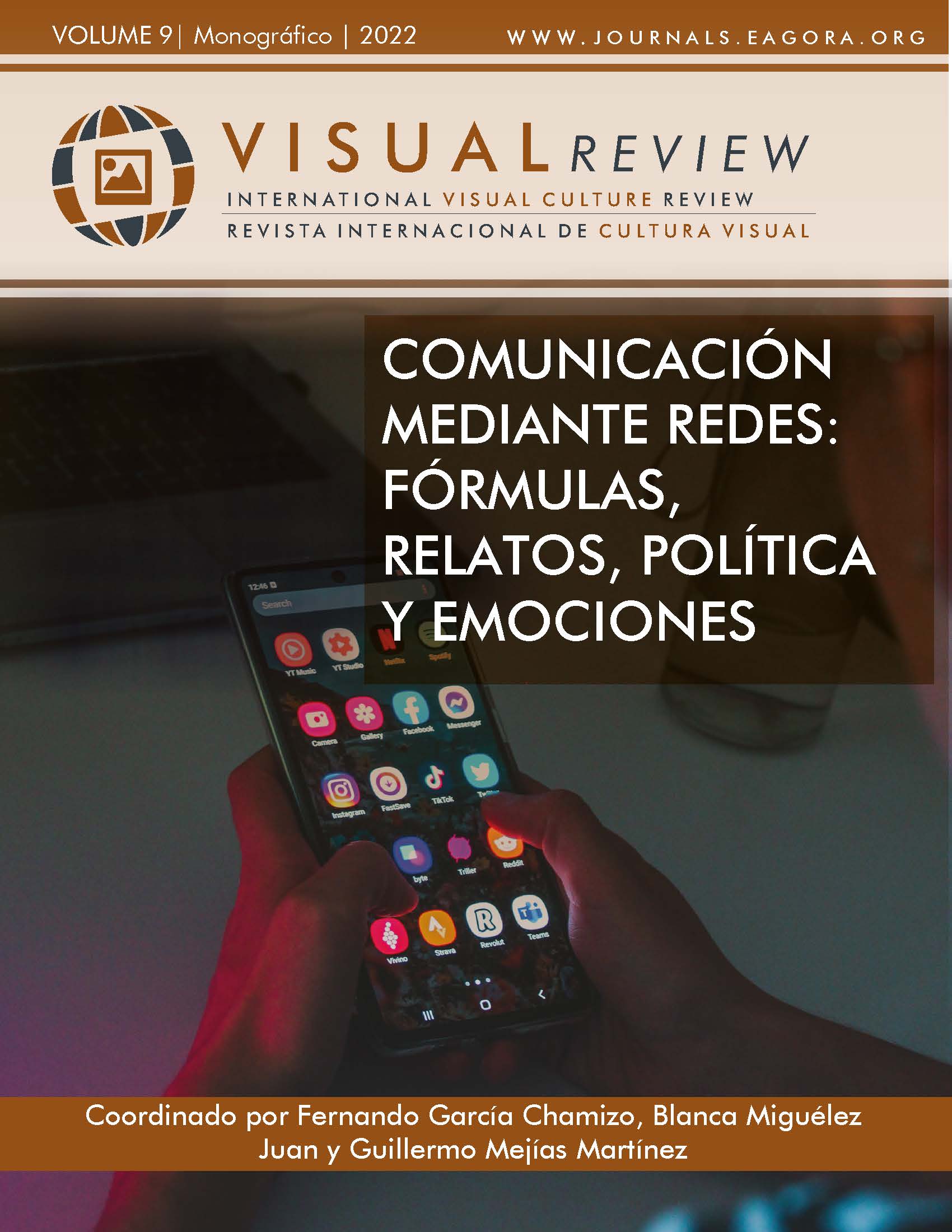Creative thinking: a programme to develop the empowerment of creativity
Analysis and evaluation of results
DOI:
https://doi.org/10.37467/revvisual.v9.3528Keywords:
Creativity, Communication, Gamification, Innovation, AdvertisingAbstract
In a globalized and changing world, the development of the creative thinking is essential. This research analyses the performance and creative skills of the students who attend to the Degree in Public Relations and Advertising of Vigo University through the implementation of a programme to empower creativity. The methodology is quantitative and descriptive and the results are shown in four exercises which have been developed from the point of view of gamification. The findings underscore the positive effects of these kinds of dinamics in the development of the creative thinking and the needs to improve certain areas.
Downloads
References
Almerich, G., Díaz-García, I., Cebrián-Cifuentes, S., & Suárez-Rodríguez, J. (2018). Estructura dimensional de las competencias del siglo XXI en los estudiantes universitarios de educación. RELIEVE Revista Electrónica de Investigación y Evaluación Educativa, 24(1). https://doi.org/10.7203/relieve.24.1.12548 DOI: https://doi.org/10.7203/relieve.24.1.12548
Beghetto, R. A. (2019). Structured uncertainty: How creativity thrives under constraints and uncertainty. En C. A. Mullen (Ed.), Creativity Under Duress in Education? Resistive Theories, Practices, and Actions (1st ed. 2019, pp. 77-40). Springer. DOI: https://doi.org/10.1007/978-3-319-90272-2_2
Braga, N. P., & Fleith, D. S. (2018). Relação criatividade, professor e educação superior: Revisão de literatura. Psicologia, Educação e Cultura, 1(XXII), 170-185.
Brown, T. J., & Kuratko, D. F. (2015). The impact of design and innovation on the future of education. Psychology of Aesthetics, Creativity, and the Arts, 9(2), 147-151. https://doi.org/10.1037/aca0000010 DOI: https://doi.org/10.1037/aca0000010
Campos Cancino, G., & Palacios Picos, A. (2018). La creatividad y sus componentes. Creatividad y sociedad: revista de la Asociación para la Creatividad, 27, 167-183.
Castelló-Martínez, A. (2020). Las asignaturas de creatividad y estrategia en los Grados en Comunicación en España. Revista Latina, 77, 143-178. https://doi.org/10.4185/RLCS-2020-1453 DOI: https://doi.org/10.4185/RLCS-2020-1453
De Bono, E. (1991). El pensamiento lateral: Manual de creatividad. Paidós.
De la Torre, S. (2002). La creatividad de un didacta o cómo dejar huella en la enseñanza. Educar, no. extra, 35-44.
Elisondo, R. C., & Donolo, D. (2013). La lámpara maravillosa y la creatividad Experiencias en la biblioteca. Creatividad y sociedad: revista de la Asociación para la Creatividad, 21, 7-26.
Elisondo, R. C., & Piga, M. F. (2020). Todos podemos ser creativos. Aportes a la educación. Diálogos sobre educación, 20. https://doi.org/10.32870/dse.v0i20.590 DOI: https://doi.org/10.32870/dse.v0i20.590
Gajda, A., Beghetto, R. A., & Karwowski, M. (2017). Exploring creative learning in the classroom: A multi-method approach. Thinking Skills and Creativity, 24, 250-267. https://doi.org/10.1016/j.tsc.2017.04.002 DOI: https://doi.org/10.1016/j.tsc.2017.04.002
González-González, C. S. (2014). Estrategias para trabajar la creatividad en la Educación Superior: Pensamiento de diseño, aprendizaje basado en juegos y en proyectos. Revista de Educación a Distancia (RED), 40, Article 40. https://bit.ly/2Maw7i1
Jackson, N., Oliver, M., Shaw, M., Wisdom, J., & Fryer, M. (Eds.). (2006). Facilitating creativity in higher education: A brief account of National Teaching Fellows’ views. En Developing creativity in higher education: An imaginative curriculum (pp. 94-108). Routledge. DOI: https://doi.org/10.4324/9780203016503-18
Kim, K. H. (2019). Demystifying Creativity: What Creativity Isn’t and Is? Roeper Review, 41(2), 119-128. https://doi.org/10.1080/02783193.2019.1585397 DOI: https://doi.org/10.1080/02783193.2019.1585397
Latorre-Cosculluela, C., Vázquez-Toledo, S., Rodríguez-Martínez, A., & Liesa-Orús, M. (2020). Design Thinking: Creatividad y pensamiento crítico en la universidad. Revista Electrónica de Investigación Educativa, 22. https://doi.org/10.24320/redie.2020.22.e28.2917 DOI: https://doi.org/10.24320/redie.2020.22.e28.2917
Liberal Ormaechea, S., Sierra Sánchez, J., Molares-Cardoso, J., & López de Aguileta-Clemente, C. (2021). Restos y desafíos de la innovación educativa en la era post COVID-19. En Retos y desafíos de la innovación educativa en la era post COVID-19 (pp. 205-229). McGraw-Hill.
Parra-González, M. a E., Segura-Robles, A., & Romero-García, C. (2020). Análisis del pensamiento creativo y niveles de activación del alumno tras una experiencia de gamificación. Educar, 56(2), 475-489. https://doi.org/10.5565/rev/educar.1104 DOI: https://doi.org/10.5565/rev/educar.1104
Quimis Reyes, J. R., Barberán Cevallos, J. P., & Roca Piloso, P. (2019). Creatividad profesional: Necesidad de la universidad actual. Opuntia Brava, 11, 35-44. https://doi.org/10.35195/ob.v11iEspecial.656 DOI: https://doi.org/10.35195/ob.v11iEspecial.656
Runco, M. A., & Jaeger, G. J. (2012). The Standard Definition of Creativity. Creativity Research Journal, 24(1), 92-96. https://doi.org/10.1080/10400419.2012.650092 DOI: https://doi.org/10.1080/10400419.2012.650092
Sánchez, A., & De la Morena, M. (2002). Pensamiento Creativo. En Universidad Camilo Jose Cela (Madrid) (Ed.), Enciclopedia de pedagogia (Vol. 1, pp. 161-172). Espasa.
Schnarch, A. (2012). Creatividad aplicada: Cómo estimular y desarrollar la creatividad a nivel personal, grupal y empresarial. Ecoe Ediciones. https://library.biblioboard.com/content/c97d75de-9c99-489a-a246-ae76d264731a
Steinbeck, R. (2011). Building Creative Competence in Globally Distributed Courses through Design Thinking. Comunicar, 19(37), 27-35. https://doi.org/10.3916/C37-2011-02-02 DOI: https://doi.org/10.3916/C37-2011-02-02
Sternberg, R. J., & Lubart, T. I. (1996). Investing in creativity. American Psychologist, 51(7), 677-688. https://doi.org/10.1037/0003-066X.51.7.677 DOI: https://doi.org/10.1037/0003-066X.51.7.677
Torrance, E. P. (1995). Insights about creativity: Questioned, rejected, ridiculed, ignored. Educational Psychology Review, 7(3), 313-322. https://doi.org/10.1007/BF02213376 DOI: https://doi.org/10.1007/BF02213376
Treffinger, D. J., Isaksen, S. G., & Stead-Dorval, K. B. (2006). Creative problem solving: An introduction (4th ed). Prufrock Press.
Werbach, K. (221d. C.). (Re)Defining Gamification: A Process Approach. En A. Spagnolli, L. Chittaro, & L. Gamberini (Eds.), Persuasive Technology (Vol. 8462, pp. 266-272). Springer International Publishing. http://dx.doi.org/10.1007/978-3-319-07127-5_23 DOI: https://doi.org/10.1007/978-3-319-07127-5_23
Zainuddin, Z. (2018). Students’ learning performance and perceived motivation in gamified flipped-class instruction. Computers & Education, 126, 75-88. https://doi.org/10.1016/j.compedu.2018.07.003 DOI: https://doi.org/10.1016/j.compedu.2018.07.003
Zambrano Yalama, N. I. (2019). El desarrollo de la creatividad en estudiantes universitarios. Revista Conrado, 15(67), 355-359.
Downloads
Published
How to Cite
Issue
Section
License
Those authors who publish in this journal accept the following terms:
- Authors will keep the moral right of the work and they will transfer the commercial rights.









